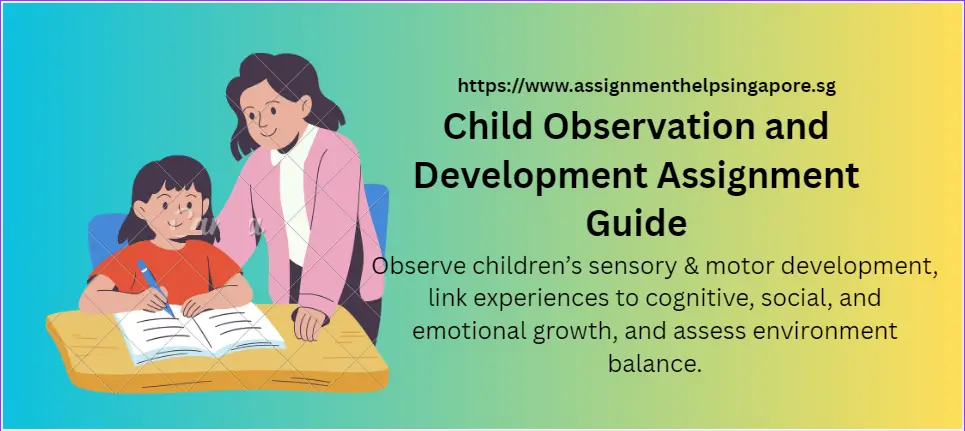
Contents
ECE200 : Supporting Sensory and Motor Development – Child Observation and Development
Question 1
Observe a child or a group of children over the course of one day in an early childhood education setting and present the flow of activities in a table as shown below.
For each activity, indicate how specific senses are functioning (Sensory development), and how specific motor skills (gross motor, fine motor, compound movements, etc.) are utilised (Motor development). You may include details of what you observed but keep your notes concise.
| Age of child / children: | |||
| Time | Activity | Sensory development | Motor development |
| E.g. 8:30am | E.g. Arrival and health check | E.g. “Sense” – “to …” | E.g. Gross motor – “skill”Fine motor – “skill” |
(20 marks)
Question 2
(Continued from question 1) Using the context of a particular child engaged in one of the activities indicated above, illustrate how the child’s sensory and motor experiences influence other developmental domains (cognitive, social, emotional, and/or language development) during the activity. Apply concepts from materials covered in this course to support your discussion.
If necessary, use a pseudonym or first initial when referring to the individual.
(20 marks)
Question 3
(Continued from question 1) For one of the activities indicated above, distinguish between child-initiated and adult-initiated elements of the activity. Comment on the current balance observed with the activity. If it is good, how so? If it can be improved, illustrate ways to strike a better balance between child-initiated and adult-initiated qualities of experience. Use local frameworks and course materials to substantiate your discussion.
(20 marks)
Question 4
(Continued from question 1) Select one activity from your schedule of observed activities in question 1 and answer both parts a) and b) below.
a) Describe and appraise the indoor and/or outdoor environment of the activity based on considerations for conducive engagement and learning.
Your discussion should include at least ONE (1) of the following considerations:
- Factors that support or hinder children’s sensorial regulation or active participation
- How the environment promotes sensory and motor development
- How the environment fosters child-initiated and/or adult-initiated activity
(15 marks)
b) Suggest how one can modify the environment (physical, sensorial, temporal, interactional, relational, etc.) or facilitative strategy in the activity to cater to children with developmental variations (sensory processing issues or atypical motor development). Explain how the suggested adaptations will better support children with diverse learning needs.
Childhood Assignment Answers: Expert Answers on Above Questions on Child Development
Observation table
The children selected for analysis is a four years old, and observation timing includes 2.5 hour observation with 30 minutes of intervals between each activity which includes arrival and greeting, outdoor play, art activity, snacks time and storytelling. The observation will include an analysis of sensory development and motor development. The greeting activity would analyse the ability of children to use sight to recognise teachers, whereas outdoor play would analyse the touch and vision ability of the child. The art activity would explore the child’s ability to recognise colours and shape and the snack time would evaluate the ability of the child to smell and taste the food. The story telling would check the sensory development in the form of visual cues and auditory input and the ways in which the child responds. The motor development that would be focussed are gross motor skills and fine motor skills.
Influence on other developmental domains
These activities would result in the development of various other areas within the child which include cognitive skills in the form of identifying colors and shapes, language skills whereby the child is required to speak aloud, social emotional development when engaging with peers.
Child initiated versus adult initiated activity
The painting activity would include both the child initiated elements and adult initiated elements in the form of selecting colours, creating shapes and adult elements including explaining instructions.
Environment appraisal
A bright environment would be provided with washable surfaces which will help in encouraging sensory exploration and fine motor engagement.
Motivation for diverse needs
Children with sensory sensitivities would be provided with softer lighting and noise cancelling area, and children with motor difficulties would be provided with adaptive tools such as larger paper.
| Disclaimer: This answer is a model for study and reference purposes only. Please do not submit it as your own work. |
Want a Full Worked Out Answer with References?
If you are struggling to complete your early childhood assignment on sensory and motor development, consider taking assistance from professional assignment helpers in Singapore. With expert’s step by step guidance and suggestions, you would be able to complete your childhood development assignment with perfection.




